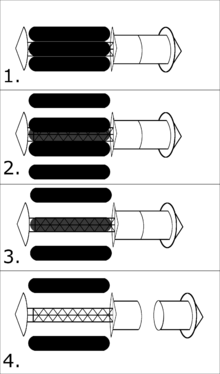Longshot project
Project Longshot is a study from 1988 with the aim of designing an interstellar spaceship that can transport research satellites to the Alpha Centauri binary star system in the Centaurus constellation, about 4.34 light years away .
concept
The concept was developed by the United States Naval Academy and the National Aeronautics and Space Administration (NASA). The spaceship should be equipped with a nuclear pulse drive . Longshot was designed so that it could have been built from Space Station Alpha (a previous version of the International Space Station ISS). One difference to the similar Daedalus project was that Longshot was only supposed to use existing technology, but it was accepted that additional development might be required.
Unlike the project Daedalus in which a fusion reactor with a closed circuit ( English closed cycle should be used), long shot should its power by nuclear fission of a long-lived nuclear reactor relate. With an initial output of 300 kW , the reactor operates a number of lasers in the drive, which, just as in the Daedalus project, are used to start inertial fusion . Another fundamental difference to the Daedalus project is that Longshot's energy supply does not depend on a fusion reactor, as this is taken over by the outer reactor.
The reactor should also operate a communication laser with a maximum power of 250 kW for data transmission to earth. Most of the time during the outward flight, the communication laser should only be operated in economy mode in order to send data via interstellar matter . At the destination of the journey, the main drive section is dropped and the entire energy throughput is used for communication at 1 k bit / s.
Longshot would weigh 396 t (including 264 t helium-3 / deuterium as fuel) at launch . The payload including the nuclear reactor weighs around 30 t without the main propulsion section.
A notable difference between the two studies in mission planning is that Longshot enters orbit around the target star, while Daedalus flies by in a relatively short time.
The trip to Alpha Centauri B would take about a hundred years. Due to the distance of 4.34 light years , the first data from the target location would not reach Earth until 4.34 years after arrival .
See also
swell
- Keith A. Beals, Martin Beaulieu, Frank J. Dembia, Joseph Kerstiens, Daniel L. Kramer, Jeffrey R. West, James A. Zito: Project Longshot - An unmanned probe to Alpha Centauri. (PDF; 2.5 MB) In: NASA Technical Reports Server. US Naval Academy, 1988, accessed July 23, 2008 (NASA-CR-184718).
